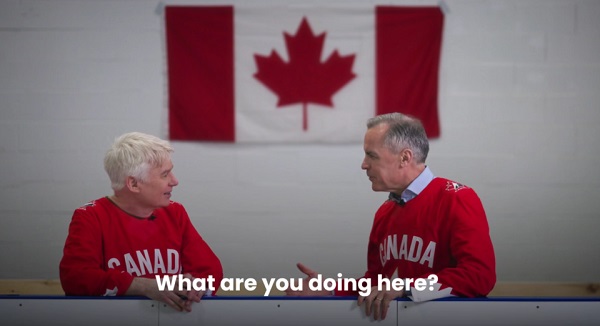Business
List of items Canadians will pay 25% tariffs on includes US made orange juice, wine, beer, and clothing

From the Department of Finance Canada
Canada Announces $155B Tariff Package in Response to U.S. Tariffs
Dominic LeBlanc, Minister of Finance and Intergovernmental Affairs, and Mélanie Joly, Minister of Foreign Affairs, announced that the Government of Canada is moving forward with 25 per cent tariffs on $155 billion worth of goods in response to the unjustified and unreasonable tariffs imposed by the United States (U.S.) on Canadian goods.
These countermeasures have one goal: to protect and defend Canada’s interests, consumers, workers, and businesses.
The first phase of our response will include tariffs on $30 billion in goods imported from the U.S., effective February 4, 2025, when the U.S tariffs are applied. The list includes products such as orange juice, peanut butter, wine, spirits, beer, coffee, appliances, apparel, footwear, motorcycles, cosmetics, and pulp and paper. A detailed list of these goods will be made available shortly.
Minister LeBlanc also announced that the government intends to impose tariffs on an additional list of imported U.S. goods worth $125 billion. A full list of these goods will be made available for a 21-day public comment period prior to implementation, and will include products such as passenger vehicles and trucks, including electric vehicles, steel and aluminum products, certain fruits and vegetables, aerospace products, beef, pork, dairy, trucks and buses, recreational vehicles, and recreational boats.
In addition to this initial response, Ministers LeBlanc and Joly reiterated that all options remain on the table as the government considers additional measures, including non-tariff options, should the U.S. continue to apply unjustified tariffs on Canada.
Less than 1 per cent of the fentanyl and illegal crossings into the United States come from Canada. We will not stand idly by when our nation is being needlessly and unfairly targeted. The government will defend Canadian interests and jobs. We stand ready to support affected workers and businesses.
The U.S. administration’s decision to impose tariffs will have devastating consequences for the American economy and people. Tariffs will upend production at U.S. auto assembly plants and oil refineries, raise costs for American consumers—at gas pumps and grocery stores—and put American prosperity at risk.
The government is also taking steps to mitigate the impact of its tariff countermeasures on Canadian workers and businesses by establishing a remission process to consider requests for exceptional relief from the tariffs imposed as part of Canada’s immediate response, as well as any future tariff actions. More details about the framework and process will be announced in the coming days.
The government continues to work closely with provincial and territorial governments, as well as business, labour, and other leaders to advance a robust Team Canada response, and to advocate with U.S. decision-makers on behalf of all Canadians to safeguard and strengthen Canada’s economy.
“This first set of countermeasures is about protecting—and supporting—Canada’s interests, workers, and industries. These U.S. tariffs are plainly unjustified. They are detrimental to both American and Canadian families and businesses. Working with provincial, territorial and industry partners, our singular focus is to get them removed as quickly as possible. Until then, our response will be balanced and resolute.”
– The Honourable Dominic LeBlanc,
Minister of Finance and Intergovernmental Affairs
“Canada will not stand by as the U.S., our closest and most important trading partner, applies harmful and unjustified tariffs against us. With these countermeasures, we are defending Canada’s interests and are doing what is best for Canadians and our economy.”
– The Honourable Mélanie Joly,
Minister of Foreign Affairs
Quick facts
- Canada is the top customer for U.S. goods and services exports and a critical supplier of goods and services integral to the U.S. economy, with Canada buying more U.S. goods than China, Japan, France and the United Kingdom combined.
- Millions of jobs on both sides of the border depend on this relationship, and every day over US$2.5 billion worth of goods and services crosses the border.
- Canada is the largest export market for 36 states and is among the top three for 46 states, with 43 states exporting over US$1 billion to Canada every year.
- Of the U.S.’s top five trading partners, Canada is the only country with whom the U.S. has a trade surplus in manufacturing (US$33 billion in 2023).
- The tariffs announced today by the Government of Canada will not apply to U.S. goods that are in transit to Canada on the day on which these countermeasures come into force.
- As a first line of defence, Canada’s robust system of economic support programs is available to help businesses and workers directly impacted by U.S. tariffs. This includes financing and advisory supports for businesses through financial Crown corporations and supports for workers through the Employment Insurance program. As we redouble our efforts to improve Canada’s investment, productivity and competitiveness in collaboration with provinces, territories and the business community, the government will proactively monitor impacts across sectors and the economy, and will bring forward additional measures to support workers and businesses as needed.
- On December 17, 2024, the Government of Canada announced Canada’s Border Plan, which aims to bolster border security, strengthen our immigration system, and keep Canadians safe.
- The Plan is backed by an investment of $1.3 billion and built around five pillars: 1) Detecting and disrupting fentanyl trade; 2) Introducing significant new tools for law enforcement; 3) Enhancing operational coordination; 4) Increasing information sharing; and 5) Minimizing unnecessary border volumes.
Business
The great policy challenge for governments in Canada in 2026

From the Fraser Institute
According to a recent study, living standards in Canada have declined over the past five years. And the country’s economic growth has been “ugly.” Crucially, all 10 provinces are experiencing this economic stagnation—there are no exceptions to Canada’s “ugly” growth record. In 2026, reversing this trend should be the top priority for the Carney government and provincial governments across the country.
Indeed, demographic and economic data across the country tell a remarkably similar story over the past five years. While there has been some overall economic growth in almost every province, in many cases provincial populations, fuelled by record-high levels of immigration, have grown almost as quickly. Although the total amount of economic production and income has increased from coast to coast, there are more people to divide that income between. Therefore, after we account for inflation and population growth, the data show Canadians are not better off than they were before.
Let’s dive into the numbers (adjusted for inflation) for each province. In British Columbia, the economy has grown by 13.7 per cent over the past five years but the population has grown by 11.0 per cent, which means the vast majority of the increase in the size of the economy is likely due to population growth—not improvements in productivity or living standards. In fact, per-person GDP, a key indicator of living standards, averaged only 0.5 per cent per year over the last five years, which is a miserable result by historic standards.
A similar story holds in other provinces. Prince Edward Island, Nova Scotia, Quebec and Saskatchewan all experienced some economic growth over the past five years but their populations grew at almost exactly the same rate. As a result, living standards have barely budged. In the remaining provinces (Newfoundland and Labrador, New Brunswick, Ontario, Manitoba and Alberta), population growth has outstripped economic growth, which means that even though the economy grew, living standards actually declined.
This coast-to-coast stagnation of living standards is unique in Canadian history. Historically, there’s usually variation in economic performance across the country—when one region struggles, better performance elsewhere helps drive national economic growth. For example, in the early 2010s while the Ontario and Quebec economies recovered slowly from the 2008/09 recession, Alberta and other resource-rich provinces experienced much stronger growth. Over the past five years, however, there has not been a “good news” story anywhere in the country when it comes to per-person economic growth and living standards.
In reality, Canada’s recent record-high levels of immigration and population growth have helped mask the country’s economic weakness. With more people to buy and sell goods and services, the overall economy is growing but living standards have barely budged. To craft policies to help raise living standards for Canadian families, policymakers in Ottawa and every provincial capital should remove regulatory barriers, reduce taxes and responsibly manage government finances. This is the great policy challenge for governments across the country in 2026 and beyond.
Business
How convenient: Minnesota day care reports break-in, records gone

A Minneapolis day care run by Somali immigrants is claiming that a mysterious break-in wiped out its most sensitive records, even as police say officers were never told that anything was actually stolen — a discrepancy that’s drawing sharp attention amid Minnesota’s spiraling child care fraud scandal.
According to the center’s manager, Nasrulah Mohamed, someone forced their way into Nakomis Day Care Center earlier this week by entering through a rear kitchen area, damaging a wall and accessing the office. Mohamed told reporters the intruder made off with “important documentation,” including children’s enrollment records, employee files, and checkbooks tied to the facility’s operations.
But a preliminary report from the Minneapolis Police Department tells a different story. Police say no loss was reported to officers at the time of the call. While the department confirmed the center later contacted police with additional information, an updated report was not immediately available.
Video released by the day care purporting to show damage from the incident depicts a hole punched through drywall inside what appears to be a utility closet, with stacks of cinder blocks visible just behind the wall — imagery that has only fueled skepticism as investigators continue to unravel what authorities have described as one of the largest fraud schemes ever tied to Minnesota’s human services programs.
Mohamed blamed the alleged break-in on fallout from a viral investigation by YouTuber Nick Shirley, who recently toured nearly a dozen Minnesota day care sites while questioning whether they were legitimately operating. Shirley’s video has racked up more than 110 million views. Mohamed insisted the coverage unfairly targeted Somali operators and said his center has since received what he described as hateful and threatening messages.
A manager at the Nokomis Daycare Center in Minneapolis detailed "extensive vandalism" at the facility during a Wednesday news conference.
Manager Nasrulah Mohamed reported that the suspect stole important employee and client documents, an incident he attributed to YouTuber Nick… pic.twitter.com/71nNTSXdTT
— FOX 9 (@FOX9) December 31, 2025
“This is devastating news, and we don’t know why this is targeting our Somali community,” Mohamed said, calling Shirley’s reporting false. Nakomis Day Care Center was not among the facilities featured in the video.
The break-in claim surfaced as law enforcement and federal officials continue to expose a massive fraud network centered in Minneapolis, involving food assistance, housing, and child care payments. Authorities say at least $1 billion has already been identified as fraudulent, with federal prosecutors warning the total could climb as high as $9 billion. Ninety-two people have been charged so far, 80 of them Somali immigrants.
Late Tuesday, the U.S. Department of Health and Human Services announced it was freezing all federal child care payments to Minnesota unless the state can prove the funds are being used lawfully. The payments totaled roughly $185 million in 2025 alone.
Minnesota Gov. Tim Walz, under intensifying scrutiny for allowing fraud to metastasize for years, responded by attacking the Trump administration rather than addressing the substance of the findings. “This is Trump’s long game,” Walz wrote on X Tuesday night, claiming the administration was politicizing fraud enforcement to defund programs — despite federal officials pointing to documented abuse and ongoing criminal cases.
Meanwhile, questions continue to swirl around facilities already flagged by investigators. Reporters visiting several sites highlighted in Shirley’s video found at least one — Quality “Learing” Center — operating with children inside despite state officials previously saying it had been shut down. The Minnesota Department of Children, Youth, and Families later issued a confusing clarification, saying the center initially reported it would close but later claimed it would remain open.
As Minnesota scrambles to respond to the funding freeze and mounting arrests, the conflicting accounts surrounding the Nakomis Day Care incident underscore a broader problem confronting state leaders: a system so riddled with gaps and contradictions that even basic facts — like whether records were actually stolen — are now in dispute, while taxpayers are left holding the bill.
-

 Energy8 hours ago
Energy8 hours agoRulings could affect energy prices everywhere: Climate activists v. the energy industry in 2026
-

 Digital ID9 hours ago
Digital ID9 hours agoThe Global Push for Government Mandated Digital IDs And Why You Should Worry
-

 Bruce Dowbiggin7 hours ago
Bruce Dowbiggin7 hours agoThe Rise Of The System Engineer: Has Canada Got A Prayer in 2026?
-

 International1 day ago
International1 day agoTrump confirms first American land strike against Venezuelan narco networks
-

 International7 hours ago
International7 hours agoMaduro says he’s “ready” to talk
-

 Opinion2 days ago
Opinion2 days agoGlobally, 2025 had one of the lowest annual death rates from extreme weather in history
-

 Business1 day ago
Business1 day agoHow convenient: Minnesota day care reports break-in, records gone
-

 Business1 day ago
Business1 day agoThe great policy challenge for governments in Canada in 2026





